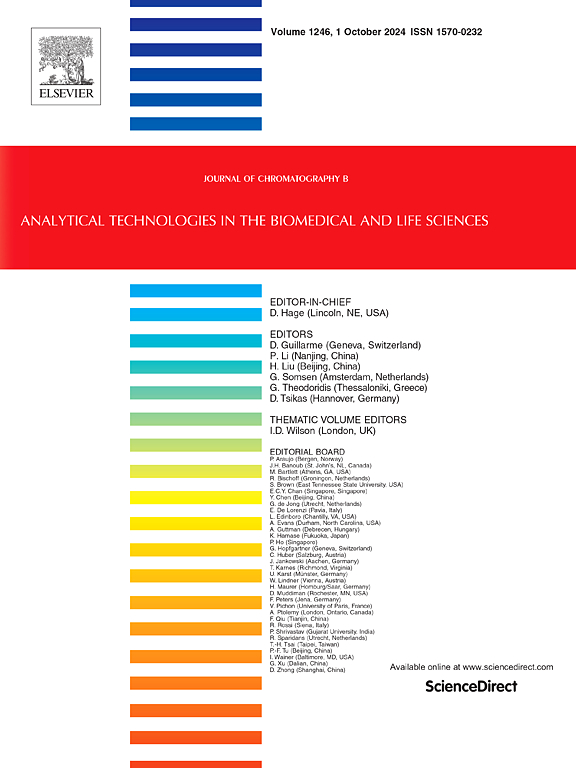Development and validation of a robust RP-HPLC method to quantitate residual 2–mercaptoethylamine in drug product formulations containing amino acid additives
IF 2.8
3区 医学
Q2 BIOCHEMICAL RESEARCH METHODS
引用次数: 0
Abstract
Bispecific antibodies have a wide range of applications in cancer immunotherapy, some of which are manufactured by controlled Fab-arm exchange requiring the reductant 2-mercaptoethylamine (2-MEA). As a process impurity, monitoring the residual 2-MEA in bispecific antibody drug product process development is needed. A novel reversed phase-high performance liquid chromatography (RP-HPLC) method for measurement of residual 2-MEA that uses 7–fluorobenzofurazan-4-sulfonic acid ammonium salt (SBD-F) as a fluorescent-detection tag in drug product formulations containing high concentrations of arginine has been developed. Using a thiol tag for residual 2–MEA eliminates any potential interference from conventional tag binding to amine groups of the formulation arginine, and potentially resulting in overestimation of the amount of impurity in a given sample. The new method has been fully validated for specificity, linearity, accuracy, range, limit of quantitation, limit of detection, and robustness. This method therefore has potential to aid in detecting residual 2-MEA content for any process that utilizes 2-MEA for bispecific antibody manufacturing.
开发并验证一种稳健的 RP-HPLC 方法,用于定量检测含有氨基酸添加剂的药物制剂中残留的 2-巯基乙胺。
双特异性抗体在癌症免疫疗法中有着广泛的应用,其中一些抗体是通过受控 Fab 臂交换制造的,需要还原剂 2-巯基乙胺(2-MEA)。作为一种工艺杂质,需要对双特异性抗体药物产品工艺开发中残留的 2-MEA 进行监测。本研究开发了一种新型反相高效液相色谱法(RP-HPLC),利用 7-氟苯并呋喃-4-磺酸铵盐(SBD-F)作为荧光检测标签,测量含有高浓度精氨酸的药物制剂中残留的 2-MEA。使用硫醇标签检测残留的 2-MEA,消除了传统标签与制剂中精氨酸胺基团结合的潜在干扰,从而避免了高估给定样品中杂质含量的可能性。新方法在特异性、线性、准确性、范围、定量限、检测限和稳健性方面都经过了充分验证。因此,该方法有望帮助任何使用 2-MEA 制造双特异性抗体的工艺检测残留的 2-MEA 含量。
本文章由计算机程序翻译,如有差异,请以英文原文为准。
求助全文
约1分钟内获得全文
求助全文
来源期刊

Journal of Chromatography B
医学-分析化学
CiteScore
5.60
自引率
3.30%
发文量
306
审稿时长
44 days
期刊介绍:
The Journal of Chromatography B publishes papers on developments in separation science relevant to biology and biomedical research including both fundamental advances and applications. Analytical techniques which may be considered include the various facets of chromatography, electrophoresis and related methods, affinity and immunoaffinity-based methodologies, hyphenated and other multi-dimensional techniques, and microanalytical approaches. The journal also considers articles reporting developments in sample preparation, detection techniques including mass spectrometry, and data handling and analysis.
Developments related to preparative separations for the isolation and purification of components of biological systems may be published, including chromatographic and electrophoretic methods, affinity separations, field flow fractionation and other preparative approaches.
Applications to the analysis of biological systems and samples will be considered when the analytical science contains a significant element of novelty, e.g. a new approach to the separation of a compound, novel combination of analytical techniques, or significantly improved analytical performance.
 求助内容:
求助内容: 应助结果提醒方式:
应助结果提醒方式:


